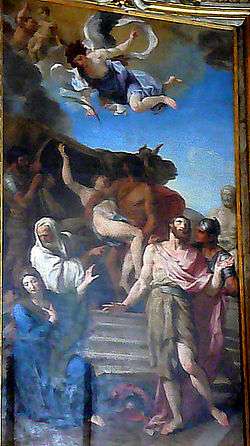Brazen bull

The brazen bull, bronze bull, or Sicilian bull, was a torture and execution device designed in ancient Greece.[1] According to Diodorus Siculus, recounting the story in Bibliotheca historica, Perillos of Athens invented and proposed it to Phalaris, the tyrant of Akragas, Sicily, as a new means of executing criminals.[2] The bull was made entirely of bronze, hollow, with a door in one side.[3] The bull was in the form and size of an actual bull and had an acoustic apparatus that converted screams into the sound of a bull. The condemned were locked in the device, and a fire was set under it, heating the metal until the person inside roasted to death.
Reign of Phalaris

Phalaris commanded that the bull be designed in such a way that its smoke rose in spicy clouds of incense. The head of the bull was designed with a complex system of tubes and stops so that the prisoner's screams were converted into sounds like the bellowing of an infuriated bull. According to legend, when the bull was reopened, the victim's scorched bones "shone like jewels and were made into bracelets."[4]
Perillos said to Phalaris: "His screams will come to you through the pipes as the tenderest, most pathetic, most melodious of bellowings." Perillos believed he would receive a reward for his invention. Instead, Phalaris, who was disgusted by these words, ordered its horn sound system to be tested on Perillos himself. When Perillos entered, he was immediately locked in and the fire was set, so that Phalaris could hear the sound of his screams. Before Perillos could die, Phalaris opened the door and took him away. After freeing him from the bull, Phalaris took Perillos to the top of a hill and threw him off, killing him. Phalaris himself is said to have been killed in the brazen bull when he was overthrown by Telemachus, the ancestor of Theron.
Possible link to Carthaginian sacrifice
Biblical scholars link the design of the Brazen Bull to statues of the Carthaginian deity Baal Hammon (often identified with the Biblical Moloch) in which infants were sacrificed alive within a bronze, calf-headed statue of the deity by being placed on the hands of the statue and sliding down into the bronze furnace.[5] The noises of the child's screams were often drowned out by drumming and dancing, since the sacrificial altars did not have the pipes system that the Brazen Bull had (see Tophet). The practices of the city of Tophet are also cited by scholars to be the inspiration for the Brazen Bull because of Akragas' Carthaginian roots.[6]
The story of the bull cannot be dismissed as pure invention. Pindar, who lived less than a century afterwards, expressly associates this instrument of torture with the name of the tyrant.[7]

Roman persecution of Christians
The Romans were reputed to have used this torture device to kill some Christians, notably Saint Eustace, who, according to Christian tradition, was roasted in a brazen bull with his wife and children by Emperor Hadrian. The same happened to Saint Antipas, Bishop of Pergamon during the persecutions of Emperor Domitian and the first martyr in Asia Minor, who was roasted to death in a brazen bull in AD 92.[8] The device was still in use two centuries later, when another Christian, Pelagia of Tarsus, is said to have been burned in one in 287 by the Emperor Diocletian.
The Catholic Church discounts the story of Saint Eustace's martyrdom as "completely false".[9]

Visigothic kingdom of Toulouse
According to the Chronica caesaraugustana, Burdunellus, a Roman usurper, was roasted in a brazen bull by the king Alaric II in 497. Priscillian, the first Christian heretic executed by order of the Catholic Church, was reportedly executed in the brazen bull along with two other followers.
In film
The 2011 film Immortals shows three maidens of an oracle being tortured in a brazen bull.
The 2011 film Red Riding Hood features a nearly identical device, albeit in the form of an elephant.
The 2010 movie Saw 3D shows a woman dying in a brazen bull.
See also
References
- Notes
- ↑ Diehl & Donnelly 2008, p. 37
- ↑ Biblioteca Historica, IX, 18-19
- ↑ Diehl & Donnelly 2008, p. 39
- ↑ Thompson 2008, p. 30
- ↑ Rundin, John S. (Fall 2004). "Pozo Moro, child sacrifice, and the Greek legendary tradition". Journal of Biblical Literature. Society of Biblical Literature. 123 (3): 425+. doi:10.2307/3268041. Retrieved October 25, 2013.
- ↑ Bohak, Gideon (January 2000). "Classica Et Rabbinica I: the Bull of Phalaris and the Tophet". Journal for the Study of Judaism in the Persian, Hellenistic, and Roman period. BRILL. 31 (1): 203–216. doi:10.1163/157006300X00107. Retrieved October 25, 2013.
- ↑ Pindar, Pythian 1
- ↑ The Seat of Satan: Ancient Pergamum
- ↑ "Martyrologium Romanum" (Libreria Editrice Vaticana, 2001 ISBN 88-209-7210-7)
- Bibliography
External links
![]() Media related to Bronze Bull at Wikimedia Commons
Media related to Bronze Bull at Wikimedia Commons